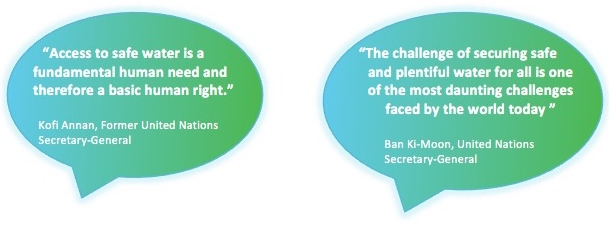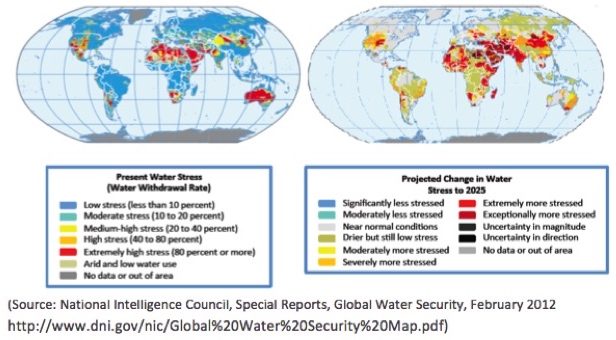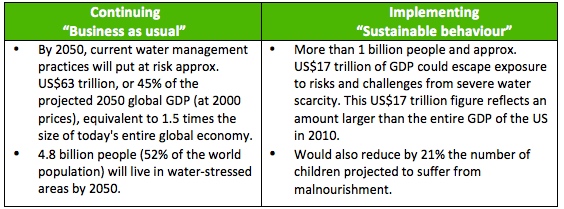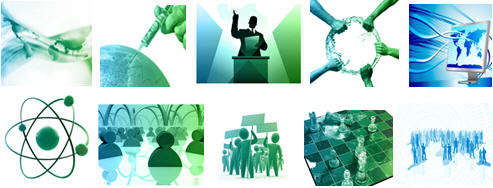February 2015: Demand for many resources already exceeds what the planet can supply. A rapidly growing global population and rising incomes in many parts of the world means more people, consuming more resources: Food, water, and energy, as well as goods and services. Already we are well past the point where the Earth can replenish the resources we consume and if current consumption trends continue, by the mid-2030s analysts suggest the world’s population will demand twice as many resources as the planet can supply – risking disasters and conflicts as people and nations compete for ever scarcer resources.
Water is now being referred to as the “new oil.” Increased per capita use in rapidly developing economies (RDEs) and greater scarcity of freshwater worldwide, exacerbated by pollution and climate change, means individuals and businesses will need to reassess the value of what has been to date a “free” resource. There will likely be increased geopolitical tensions over control of water supplies, given that well over half the world’s countries share critical water resources with other nations. In this briefing we explore the challenges around increasing water scarcity as well as some innovative ways that these are being tackled.

Also see our slideshow presentation of The Water Challenge
Living in a world of water insecurity
Water is crucial for all aspects of life, but fresh, accessible water is a scarce and unevenly distributed resource that does not correspond well with patterns of human development. Due to demographic, economic, and social changes global freshwater consumption rose at twice the rate of population growth in the 20th century – today around 1.2 billion people live in areas considered to be water stressed and, by 2025, the UN estimates that 1.8 billion people will be living in severely water-stressed areas.

In water stressed areas, insecurity over access to safe drinking water and pollution are major issues. Conserve Energy Future has compiled a list of 40 troubling facts about water pollution, some of which are below. For the complete list, click here.
- 80% of water pollution is caused by domestic sewage, for example throwing garbage on open ground and into water bodies.
- Around 70% of industrial waste is dumped into water bodies where it pollutes the usable water supply.
- Leather and chemical industries are major contributors to water pollution, in particular in emerging markets.
- 20% of the groundwater in China is used as drinking water. However, the water is highly contaminated with carcinogenic chemicals which cause high levels of water pollution. The World Bank claims that China’s water crisis costs the country more than 2% of GDP, mostly because of damage to health.
- Groundwater in Bangladesh is contaminated with arsenic; about 85% of the total area of Bangladesh has contaminated groundwater.
- In the U.S., 40% of rivers and 46% of lakes are so polluted that they are considered unhealthy for swimming, fishing and aquatic life.
The impact of water stress and insecurity
From Africa to the Middle East and California, freshwater resources are drying up, leaving many millions of people without sufficient access to safe drinking water. Access to water is a serious threat to the world – think how water issues impact food production, energy supply, increased poverty, and escalating social tensions. According to the World Economic Forum Global Risks 2014 report, water insecurity is now one of the top 3 highest risks to global development, only outpaced by financial crises and climate change.
The political challenge – Raising the potential for conflict/war
Water is increasing becoming a competitive resource; according to The Pacific Institute, which studies the impact of water on global security, there has been a fourfold increase in violent confrontations over water within the last decade. Peter Gleick, president of the Pacific Institute believes “…the risk of conflict over water is growing – not shrinking – because of increased competition, because of bad management and, ultimately, because of the impacts of climate change.” (Source: The Guardian). Below are just some examples of such violent conflicts. Click here for a more complete list.
- Iraq/Syria 2014: Fighters with the Islamic State in Iraq and Syria (ISIS) advanced on the Haditha Dam raising the possibility of catastrophic damage and flooding. The ISIS militants are also fighting for control of the Euphrates River Dam as government forces seek to halt their advance. (Source: Pacific Insitute)
- Mexico 2014: In a village in Mexico a confrontation over a water spring between 1,500 police and residents left more than 100 police injured and five people arrested. And it’s just the latest in a series of clashes. Local governments say they are trying to extend municipal water supply to the area while residents are afraid the objective is to take control over a local water source. (Source: Pacific Insitute)
The societal challenge – Putting strain on vulnerable populations
The lack of access to clean water is putting a strain on millions of already vulnerable people, in particular, in less developed countries. Co-founder of Water.org Matt Damon says, “Access to water isn’t an end in itself. Access to water is access to education, access to work, access – above all – to the kind of future we want for our own families, and all the members of our human family.” (Source: water.org)
- 783 million people do not have access to clean water and almost 2.5 billion do not have access to adequate sanitation. (Source: UN Water)
- 6 to 8 million people die annually from the consequences of disasters and water-related diseases. Water and sanitation claims more lives through disease than any war claims through guns. (Source: UN Water)
- Women and children spend 200 million hours per day collecting water. (Source: water.org)
The economic challenge – Threatening economic growth trajectory
As soon as 2030 global water demand could exceed supply by up to 40% if no action is taken to secure sufficient water supplies. The threat is real and smarter water management is necessary to sustain sufficient economic growth in the future. In 2011 Veolia Water released a report showing the pro and cons of “business as usual” and “sustainable” water management.

The environmental challenge – Increasing the threat to natural ecosystems
Protecting the environment means protecting the human race. However, despite greater environmental awareness some people still dispose of non-degradable rubbish such as furniture, metal, and plastic items in in the world’s natural waterways, ignoring the risk of contaminating water supplies and posing hazards for wildlife. The main threats to freshwater wildlife are habitat loss and fragmentation, pollution, and invasive species.
- Falling by 76%, populations of freshwater species declined more rapidly than marine (39%) and terrestrial (39%) populations.(Source: Living Planet Report 2014)
- The most dramatic regional Living Planet Index (LPI) decrease occurred in South America, followed closely by the Asia-Pacific region. (Source: Living Planet Report 2014)
- Fourteen billion pounds of garbage, mostly plastic, is dumped into the ocean every year killing marine life and polluting oceans. (Source: Conserve Energy Future)
How the world is responding to the water challenge through innovation
Water is a shared responsibility between societies, governments, businesses, individuals and other stakeholders but the implications of our current and future water challenges seem, from time to time, quite overwhelming. The water quantity challenge, in addition to the water quality challenge posed by increasing threats from wastewater, will demand significant shifts in global attitudes to water from all these players, in terms of usage, pricing and ways of living and operating. In parts of China, just one example amongst many countries, incidents of pollution and shortages of supply have paralyzed business operations. This disrupts global value chains, putting pressure on business and corporate reputations, even if regulatory requirements have been met. It’s time to go beyond compliance to develop radical new approaches to agriculture, water recycling, infrastructure, industrial processes, and wastewater management – and consumption habits of individuals – to ensure sufficient quality and quantity of future water supplies. The vital nature of water, a resource which is often viewed as free, will increasingly confer political and economic power on those who have and/or control access to supplies, as well as those nations and organizations who are most efficient and effective in water usage.
Changing water consumption through innovation
- The Solar Sponge: Desalination is one way to provide clean, safe drinking water. However, it is often a very energy-intensive and costly process. Taking on the challenge, MIT has come up with a new technology that could change how we desalinate water. It looks a little like a sponge but it is black material, made from graphite and filled with tiny holes. It floats on top of water while soaking up sunlight. As the material heats up, it heats up a small area of water around it, and a layer of foam at the bottom keeps everything hot. The water then turns into steam that can be captured for multiple uses from drinking water to sterilization in places off the grid. (Source: Fast Company)
- Going waterless: Since the Bill & Melinda Gates Foundation invited the world to participate in its Reinvent the Toilet challenge a number of innovative approaches to waterless toilets have resulted, offering a cleaner and healthier environment and less pollution in waterways. The next big thing could be waterless or close to waterless washing machines. Today, Xeros Bead Cleaning has a commercial version of a washing machine on the market using polymer or nylon beads to clean. The beads gently rub against the clothes and up to 70% less water is needed to wash the clothes. The company hopes to market a domestic washer-dryer by 2016 that will also be able to handle dark colors and whites in the same load. (Source: CBS News)
- Game-changing technologies: The Global Cleantech 100 has identified the for-profit companies that are most likely to have a significant impact on water innovation in the next five to ten years. Click here to see the list of technologies.
Corporations in a SmartWater world
- Nestlé: In Jalisco, Mexico, Nestlé has opened its first ‘zero water’ manufacturing site in the world. It saves the water-stressed area enough water to meet the average daily consumption of 6,400 people in Mexico. Water is extracted from the factory’s dairy operations and is recycled and reused. Nestlé plans to open more ‘zero water’ manufacturing site around the world. (Source: Nestlé)
- Levi’s:In February, 2014, Levi’s announced its Chinese production partner made 100,000 pairs of Levi’s® women’s jeans with 100 percent recycled water. It saved an estimated 12 million liters of water, enough to fill almost five Olympic-size swimming pools. The company’s goal is to expand the initiative across all of its collections. Levi’s also announced that the company will share the recycled water standards with key industry stakeholders for other suppliers to use. (Source: Levi Strauss & Co)
Governments pushing better water management
- eThekwini Water & Sanitation: In the past 14 years, 1.3 million additional people in greater Durban have been connected to piped water and 700,000 people have been provided with access to toilets. eThekwini Water and Sanitation is also at the forefront of exploring technical and social solutions. One example is a mini hydro-power project: Instead of using pressure-reducing valves in pipes running down steep hillsides, the company is installing mini-turbines, using the excess pressure to generate electricity for the city’s low tension grid. The eThekwini municipality is also pioneering solutions to translate urban wastewater challenges into agricultural opportunities, as well as harvesting rainwater. Winner of the 2014 Stockholm Water Awards (Source: SIWI)
- Imposing regulations: Around the world, environmentally conscious and water stressed governments are passing new regulations on water management. Recently China, which is experiencing serious water shortages, has passed new regulations on water management, imposing extra costs for use on farmers – improving water efficiency in agriculture is considered the most effective way to achieve significant water savings in China. Elsewhere, California is experiencing the worst drought in decades and some communities are actually out of water. In July the State Water Resources Control Board imposed new restrictions on outdoor water use starting on August 1, 2014 that could result in fines of up to US$500 per violation. These are the first ever statewide rules to punish water wasters. (Source: WorldWatch Institute, San Jose Mercury News)
Working together to make a difference
- H&M & WWF: In 2013 H&M entered a three-year partnership with WWF to develop a global water strategy that will be implemented across the fashion retailer’s 48 national markets and 750 direct suppliers. (Source: The Global Trends Fieldbook: From Data to Insights to Action)
- Coca-Cola & WWF: Since 2007, they have worked together to conserve and protect priority river basins and catchments around the world; to improve water efficiency and reduce carbon emissions across Coke’s manufacturing operations; and to promote sustainable agriculture throughout the company’s supply chain. (Source: The Global Trends Fieldbook: From Data to Insights to Action)
UN Water awareness campaigns on freshwater and sanitation
- World Water day, 22 March: Focuses on the importance of freshwater and advocating for the sustainable management of freshwater resources.
- World Toilet Day, 19 November: The purpose is to make sanitation for all a global development priority and urge changes in both behavior and policy on issues ranging from improving water management to ending open-air defecation.
- Sanitation for All – The Drive to 2015: Is an advocacy campaign working to meet the Millennium Development Goals’ sanitation target and end open-air defecation.
Give us your opinion on water scarcity! Take our 2 minute survey at https://www.surveymonkey.com/s/GTwater210115
We will share the findings with you on our website http://www.globaltrends.com/ and in our March briefing.
In March: Look out for trends in action on Upstarts: Driving the entrepreneurial economy




